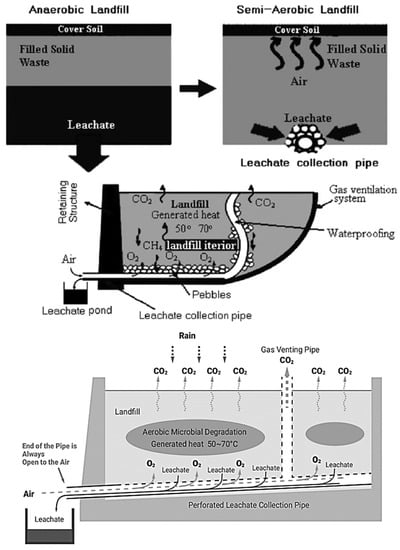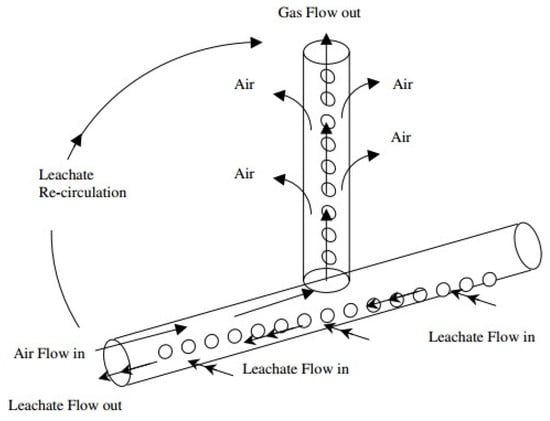You're using an outdated browser. Please upgrade to a modern browser for the best experience.
Please note this is an old version of this entry, which may differ significantly from the current revision.
Subjects:
Engineering, Environmental
Landfilling stands among the main elements in a solid waste management strategy even after the implementation of the 3Rs: reduce, recover, recycle. This is due to the fact that, in most cases, not all waste can be recovered and recycled.
- physicochemical
- solid waste
- COD
1. Introduction
The number of residents in Malaysia in the third quarter of 2022 was reported to be 32.9 million [1]. This results in a massive quantity of municipal solid waste (MSW) production of around 38,427 metric tonnes per day (1.17 kg/capita/day). A total of 82.5% of waste ends up in landfills. In the same year, the annual MSW collection reached 14 million metric tonnes [2]. Organic waste stands between 40% and 60% of waste in most developing countries. Although there are many advantages to landfilling for waste disposal, it raised serious issues because of the highly polluted leachate it creates. Leachate contaminants include more than 200 different chemicals, most of which are hazardous to the environment. Rainwater infiltrating the deposited waste at the landfill or dumpsite results in the formation of leachate. Additionally, leachate may be produced from a number of different sources, such as transpiration, groundwater intake, storing wet materials, evaporation losses, surface flow, and the hydrolysis and biodegradation of organic molecules [3]. Leachate may drain as runoff or move to the bottom of the waste body. These may pollute groundwater and surface water, endangering both aquatic life and human health. The amount and composition of leachate are influenced by a variety of variables, including seasonal weather fluctuations, landfilling methods, nature of waste type and composition, and landfill design. Due to excessive rainfall during the wet season and high evaporation rates in tropical nations, such as Malaysia, landfill leachate is quickly produced.
Knowledge in improving the treatment for this landfill leachate management control is still an ongoing process and attracted significant attention from scientists, engineers, and technologists throughout the world. Various leachate treatment techniques were developed in many different ways, including those that incorporate biological, physical, and chemical processes and their combinations. Further improvements, especially on the optimisation for cost saving, are part of the continuing efforts.
The main problem with landfill leachate is the amount and level of variability that it exhibits [4]. In order to choose the best leachate treatment method, it is necessary to characterise the leachate and estimate its risk. In addition, treating the high concentration of NH3-N in landfill leachate is a challenging process. The physicochemical method successfully eliminates heavy metals, inorganic macro-components, and refractory organic molecules from leachate. On the other hand, biological processes effectively remove dissolved organics and nutrients from leachates [5].
The age and biodegradability of the leachate limit the biological process for leachate treatment [6,7]. Physical-chemical techniques are normally necessary for lowering hazardous and refractory substances [8]. As a result, an integrated strategy combining biological with either pre- or post-physical-chemical processes is an effective choice that offers higher effluent quality [9].
2. Landfilling
Landfilling stands among the main elements in a solid waste management strategy even after the implementation of the 3Rs: reduce, recover, recycle. This is due to the fact that, in most cases, not all waste can be recovered and recycled. Open dumping or regulated dumping are the two main methods used by most developing countries to dispose of their waste. These countries normally have financial constraints to apply costly treatment systems such as materials recovery facilities, waste-to-energy technology, etc. For the same reason, Malaysia currently relies primarily on landfilling as its main way of disposing of its MSW, and this is expected to still be the favoured option for the next 10 to 15 years to come. However, due to economic limitations, proper sanitary landfill concepts have not yet been fully implemented in the whole country. There are many old and improperly designed landfill sites that are still in operation to date, and some of them are almost reaching their end of life. The leachate is still being produced and must be properly controlled.
The category of landfill could be generally grouped into anaerobic, semi-aerobic, and aerobic. In developing countries, the anaerobic landfill is the most common, where the waste is commonly discarded and covered and, sometimes, left uncovered. Open dumping is still being practised, but the trend is now towards control tipping, and more countries are moving forward towards the sanitary landfill. The anaerobic landfills produce concentrated leachate, which is difficult to treat by a conventional method to up to the standard discharge limits. This type of landfill is further constrained by fire incidents and greenhouse gas emissions, which primarily contain methane (CH4) and carbon dioxide (CO2). Quite commonly, these gases are untapped and just released untreated in developing countries due to many limitations, especially the cost factor.
On the other hand, the Fukuoka technique, or a semi-aerobic method, was established at Fukuoka University over 20 years ago and was employed in numerous sites around Japan, China, Iran, and Malaysia. However, this method was not widely adopted by many other countries. Semi-aerobic landfilling was first used in Malaysia in 1988, and since then, the quality of the leachate has improved noticeably. The Fukuoka approach can be used in developing nations in a variety of situations for various goals, such as creating new landfill sites, improving existing ones, or effectively closing ones that were already constructed. Leachate collection pipes are built beneath the semi-aerobic landfill, as shown in Figure 1.
Leachate is removed by this conduit from a disposal location. Air from an open pit is extracted into this leachate collection pipe, which then moves into the waste body. In this manner, greenhouse gases such as methane and carbon dioxide are produced less, as the process encourages aerobic biodegradation or organic matter and allows early waste stabilisation [10]. Figure 2 illustrates a typical layout of a semi-aerobic landfill.

Figure 1. Conceptual landfill design using a semi-aerobic concept [11].

Figure 2. An illustration of a landfill that uses a semi-aerobic process [12].
Gas venting and leachate collecting pipelines are crucial components of a semi-aerobic landfill system. Figure 3 shows semi-aerobic landfill leachate pipes which provide air passage and remove leachates from the waste body through the natural convection process of cold air (outside) and hot air (within the waste body). This process mimics human blood veins [13]. Additionally, these pipelines have a number of benefits. Leachate, for instance, is evacuated more quickly than it would be in landfills without these pipelines. As a result, leachate fouling in waste materials is avoided and landfills are conveniently accessible to fresh air. Aerobic environments promote microbial activity and enhance waste decomposition. Due to their placement within rocks, collection pipelines are shielded both from clogging and operational harm. Leachate seepage is less likely because leachate is quickly drained, which lowers the pressure brought on by water on the ground [14].

Figure 3. Leachate collection and gas ventilation pipes in a semi-aerobic landfill [12].
Landfills that employ a semi-aerobic concept are potentially sustainable, as they could offer various advantages over alternative solutions. When leachate flows through the pipes and is released from the sites, it lowers water pressure and prevents seepage. Garbage naturally allows fresh air to pass through it. Thus, leachate cleaning and waste stabilisation only take a short while. The amount of methane released decreases, despite an increase in carbon dioxide content. Semi-aerobic landfills also require straightforward technology, simple setup and operation, a small number of engineering protocols, equipment, and machinery, easier maintenance and operation, and inexpensive startup costs. Semi-aerobic landfills also contribute to a reduction in global warming by limiting the release of methane [13].
This entry is adapted from the peer-reviewed paper 10.3390/w15061249
This entry is offline, you can click here to edit this entry!
